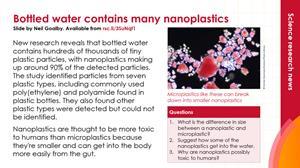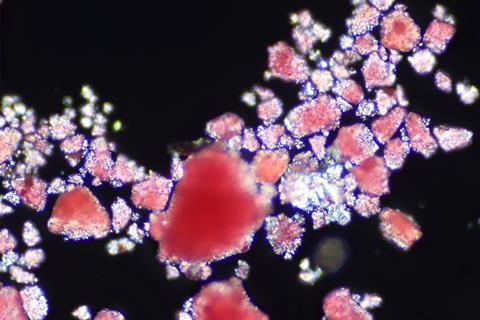New analytical technique reveals previously hidden tiny plastic particles
-

Download this
Use this story and the accompanying summary slide for a real-world context when studying nanoparticles or potable water with your 14–16 learners.
Download the story as MS Word or pdf and the summary slide as MS PowerPoint or pdf.
Scientists have discovered that bottled water contains many more tiny plastic particles than previously detected. Nanoplastics – plastic particles less than 1000 nm (1μm) in length – make up the vast majority of these.

Over the last decade, there has been growing awareness about the abundance of microplastics in our oceans, lakes and rivers. Rubber from car tyres and shoe soles, microfibres from synthetic fabrics, and large pieces of plastic that have broken down in the environment – such as carrier bags and food and drink containers – are all sources of microplastics.
Problem plastics
We know now that these plastic particles find their way from the oceans, lakes and rivers into our food and drink. Microplastics have been found in various foodstuffs such as salt, fish, fruit, vegetables and drinking water. But our understanding of the prevalence of the smallest of these particles, nanoplastics, in what we eat and drink is currently lacking. This is because it is challenging to detect such tiny particles.
Nanoplastics are thought to be more toxic to humans than microplastics because they’re smaller and can get into the body more easily from the gut.
Analytical advances
To address this issue, a team led by Wei Min and Beizhan Yan at Columbia University developed a powerful optical imaging technique able to rapidly and accurately detect nanoplastics. The scientists used their novel method to analyse three popular brands of bottled water. They successfully detected and identified plastic particles in the water down to just 100 nm in size. The seven plastic types they found included poly(ethylene terephthalate) and polyamide, which are two materials commonly used in plastic bottles.
The researchers calculated that the average litre of bottled water they tested held 240,000 particles of micro- and nanoplastics, with the latter making up about 90% of the particles detected. The authors said these concentrations were ‘two or three orders of magnitude more’ than the abundance reported previously in bottled water by studies focused only on detecting larger microplastics.
Put this in context
Read about nanotoxicologist, Vicki, who ensures that tiny nanomaterials present in everyday products are safe for consumers.
This article is adapted from Julia Robinson’s in Chemistry World.
Nina Notman
Reference
N Qian et al, Proc. Natl. Acad. Sci., 121, 3, 2024 (doi.org/10.1073/pnas.2300582121)
Download this
Summary slide with questions and the article for context when teaching 14–16 classes on nanoparticles and potable water: https://rsc.li/490ZiK8
Downloads
Nanoplastics in bottled water student sheet
Handout | PDF, Size 0.18 mbNanoplastics in bottled water student sheet
Handout | Word, Size 0.57 mbEiC summary slide nanoparticles in bottled water
Presentation | PDF, Size 0.25 mbEiC summary slide nanoparticles in bottled water
Presentation | PowerPoint, Size 1.1 mb














No comments yet